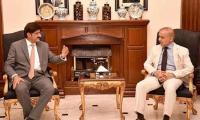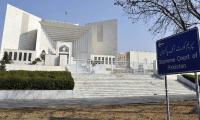The domestic political consensus about Pakistan’s economy is in. It isn’t a good look for anyone that dreams of a better day for the country’s vast majority of poor, illiterate, underserved citizens.
The consensus isn’t spoken of, or written down, but is visible in plain sight for anyone interested in the data and the evidence from three decades of economic policy, made by a military dictator (Musharraf), people’s champions (PPP), capitalist democrats (PML-N), and now reformist conservatives (PTI).
No matter who is in charge and what they have promised the people of Pakistan, the formula is the same. One, spend whatever money you can, by hook or by crook, until you run out of political and financial capital abroad (think IMF, Washington DC, Saudi Arabia and China). Two, tighten the belt of the poor and suffocate the country’s progress to re-acquire lost capital abroad. Three, as soon as the vitals stabilize, start spending like there is no tomorrow again. To call what happens to the Pakistani economy a boom-and-bust cycle is an insult to the word ‘boom’. A boom is 11 percent GDP growth per annum. Over several years. Ask India. Or China.
Pakistan’s economic cycles are more akin to ‘bust and surge’. It is like the defibrillator used to revive those that are approaching the pearly gates of Jannat as they lie, nearly dying. As soon as the battery offers enough juice for one desperate electric shock, ‘clear!’ and a surge of electricity barrels through the limp body of the economy. What does the surge do?
It does what Shaukat Tarin wants his 2021-2022 budget to do. To jump start expenditure and consumption at the household and firm level. If public investment is smart enough, if the signalling is bold, clear and comprehensive enough, if enough players in the stock market and the credit rating agencies play along, and if the political and economic capital at the IMF and other important office holds for long enough, the Tarin budget is guaranteed to generate anywhere between one percent and three percent of additional GDP growth, to what is ordinarily a static economy, if you adjust for population.
Is this a bad budget? Hell, no. The budget the government has announced is actually pretty ambitious (finally). It makes a number of promises of revenue that, if kept, will be revolutionary, but if broken, won’t be the end of days. It also makes a number of promises about expenditure, which if kept even to traditional levels of utilization, will generate jobs, consumption and economic growth. We can lament the bust and surge stasis of Pakistan’s economy till the cows come home, but that stasis is a sacred political compact between the elites and the machine bureaucracy – civilian and military – and it isn’t going anywhere. So, with the hopes and dreams of Jinnah and Iqbal left to die another day, is there any way that this coming surge can be made more useful for the people of Pakistan?
There sure is. If Prime Minister Imran Khan focuses on three of these specific ways to direct the returns of this surge toward ordinary Pakistanis more than the usual Pakistan bust and surge tends to be, he may achieve two important objectives: increasing political support for himself and the PTI old guard, and enacting some irreversible reforms that no traditional politician or military leader or hybrid arrangement will be able to reverse.
The first thing PM Khan needs to do is free the PSDP. Shaukat Tarin has arranged an amount of Rs2.1 trillion for the PSDP (federal and provincial). This is a massive amount of money. Just how massive? It is more than a billion dollars a month. Traditionally, the PSDP amounts that are announced are indicative of direction, not actual spend. Two tricks are used by the machine bureaucracy at the Finance Division to ensure this. One is to sustain the public financial management system that makes releases at a pace that limits utilization to sometimes as little as 50 percent of allocations and averaging below 80 percent. The other is to incentivize the provinces to not spend their share of the ADPs that they allocate to public investments. Provinces then end up returning money to the centre (and every province does this – no matter how federalist and democratic: here’s looking at you Chief Minister Murad Ali Shah!).
The net result is that in a record-breaking budgetary allocation for public investments, even a record-breaking spend would not quite amount to the full value of the allocation, and the manner of disbursements would ensure sub optimal utilization of these large sums of money. How can this be remedied? Through substantial changes to the accountability mechanisms in place, from NAB, to the auditor general of Pakistan, to a range of provincial and sub provincial rules that limit the speed and the quantum of spending by any one department or division and constrain the discretion of senior civil servants.
The argument is that all these rules prevent corruption. The reality is that corruption, like water, finds its path through any set of obstacles placed before it. The only thing the existing public financial management system does is to punish innovation and delivery, scare off by-the-book officers from making quick decisions, and limit the risk appetite of bureaucrats and politicians alike. If PM Khan wants to get Rs2.1 trillion closer to the people of Pakistan, he has to smash the barriers between the cash and the people.
The second thing he must do, to make that connection between cash and the people, is to double down on the BISP / Ehsaas programme. He and Dr Sania Nishtar have done a great job so far of establishing the norm of welfare as a core function and value for him and his government. It is now time to take it to the next level. Spurred by a fear of asking for more money, Dr Nishtar has had to devise nearly two dozen new initiatives at the Poverty Alleviation and Social Safety Division – raising administrative and M&E costs. Soup kitchens, small loans, subsidized groceries and numerous other innovations are noble, but not when Kafaalat (the original BISP beneficiary programme), and the Ehsaas Emergency Cash (EEC, Pakistan’s superb Covid-19 response mechanism) – have proven how powerful unconditional cash transfers can be. The total size of these grants is so low that the notion of misuse is laughable. The potential impact of these grants is so high that the notion of fragmenting valuable resources and time on proliferating new Ehsaas initiatives is tragic.
The Rs250 billion allocation for BISP/ Ehsaas is a pittance compared to what Dr Nishtar deserves as an allocation to spend on unconditional cash transfers. PM Khan needs to more than double this allocation and provide direct cash support to the inflation and joblessness affected masses of the bottom three quintiles of the country – especially in the newly merged districts, in Balochistan, and in parts of Sindh and southern Punjab.
Finally, PM Khan should get mad about how little of the excellently conceived Kamyab Jawaan loan programme has been disbursed. Building on the good work done by the previous government in the youth loans area, the Kamyab Jawaan’s Youth Entrepreneurship Scheme could transform the small-and-medium-sized enterprise landscape across the country. The problem? The banking sector is incapable of engaging with non-traditional customers. Banks are too used to the easy money they earn through debt issuance to the public sector. The State Bank of Pakistan has done a great job of slowly getting to the heart of this challenge. Many bank boards are cognizant too. A major push from the PM to unlock roughly Rs200 billion stuck in Kamyab Jawaan could unleash a substantial investment and job push in the most vital sector of the economy: youth-led SMEs.
Three ways to get cash to the people: one, free the PSDP; two, double the BISP/Ehsaas allocation; three, force the banks to issue the full Youth Entrepreneurship Scheme SME loans programme. For once, this may not only grow the economy, but do so in a way that benefits those that are usually excluded from the rewards of the Pakistani surge.
The writer is an analyst and commentator.
A health worker administers polio vaccine drops to a child during a door-to-door polio vaccination campaign in Lahore,...
Armed militants of the banned Tehreek-e-Taliban Pakistan pose for a photograph in Orakzai Agency. —...
An aeroplane of the national flag carrier of Pakistan is seen in this file photo. — AFPWhile Pakistan considers...
Representational image of a graph depicting various variables. — APP/FileInitiated by the centre and fiercely...
In this picture taken on April 16, 2023, people throng a market area during shopping in Lahore. — AFPOne of the...
Honour crimes also target men. In Sikandar Ali Lashari vs The State, SHC upheld conviction passed by ATC for honour...







